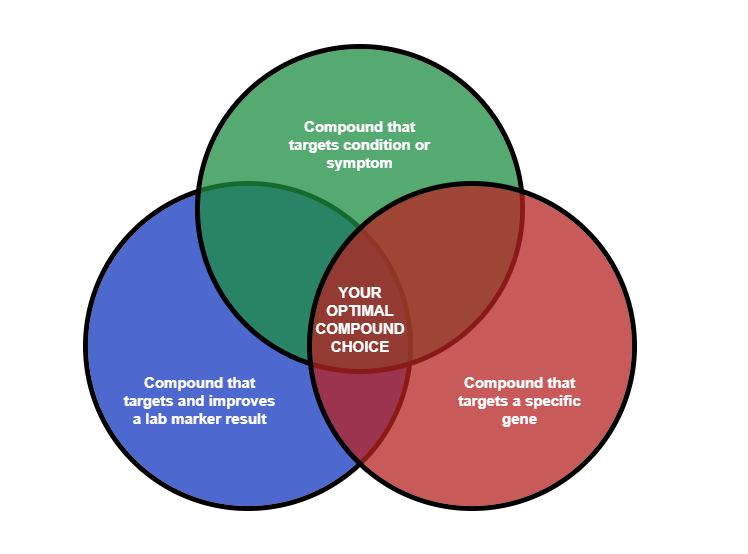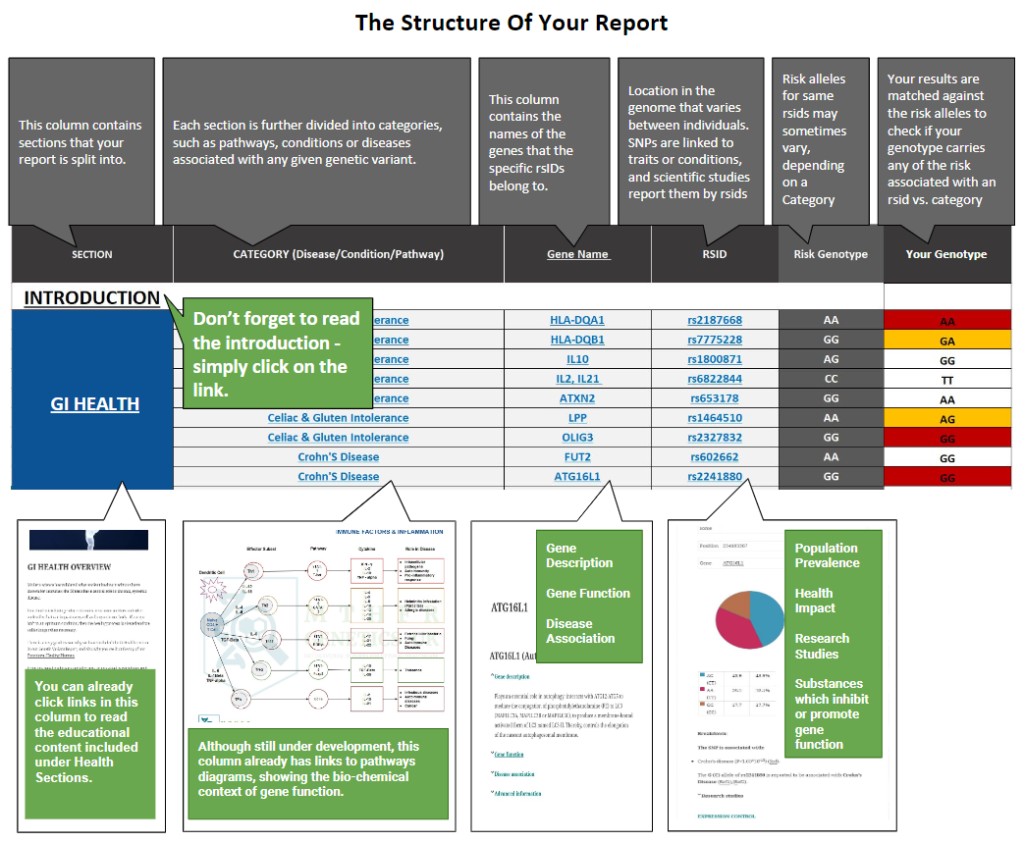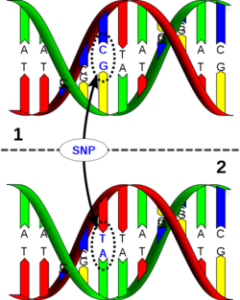GLOSSARY OF TERMS AND THE LANGUAGE USED IN THIS LIBRARY AND YOUR REPORT.
GeneThe basic unit of genetic material inherited from our parents. A gene is a section of DNA which controls part of a cell’s chemistry – particularly protein production.
risd
The rs numbers are used by researchers and databases to refer to specific SNPs. It stands for Reference SNP cluster ID.
Genome-wide association studies linking SNPs to traits or conditions usually report their results by rsid.
Allele
From the molecular biology perspective, alleles refer to the possible nucleotide bases of a variant.
Humans are called diploid organisms because they have two alleles at each genetic location, with one allele inherited from each parent. Each pair of alleles represents the genotype of a specific genetic location which is associated with a trait. (Ref.)
The four possible base pairs are:
C – Cytosine
T – Thymine
G – Guanine
A – Adenine
Genotype
The alleles that an organism has for a particular characteristic, usually written as letters (CTGA)
Two alleles are inherited for a particular genetic location. One allele is inherited from a father and one from a mother.
If the two alleles are identical (for example: CC, TT) we say that someone has a homozygous genotype. The presence of two different alleles is called heterozygous genotype (for example: CT, AG).

Variations in the DNA sequences of humans, where one of the nucleotides, belonging to a base pair of nucleotides is substituted by another nucleotide.
Or, to simplify, a SNP is a change in one letter at a specific position in a gene. For example: MTHFR C677T exchanges a C for a T at position 677 on the MTHFR gene.
SNPs can affect how humans develop diseases and respond to pathogens, chemicals, medication, vaccines, and other agents. SNPs are also thought to be key enablers in realizing the concept of personalized medicine. However, their greatest importance in biomedical research is for comparing regions of the genome between cohorts (such as matched cohorts with and without a disease). (Ref)
SNPs are determined by comparing whether an allele found at a particular position of a gene is common in a population. Alleles that are not common, are called minor alleles which form a SNP.
SNPs are not necessarily always associated with negative effects. Some SNPs can be associated with both: good and bad health outcome predictions. Our reports reflect this and thus we have designed our reports to focus on health outcome predictions/traits or conditions, in connection to specific genotypes and not prevalence of genotypes in population.
While it is true that minor alleles are more likely to be risk alleles for certain diseases in Genome Wide Association Studies (Ref), it is also true that some major alleles can sometimes carry some risks too.
In summary:
- SNPs are the most commonly occurring type of genetic variation among humans and occur within an individual’s DNA.
- Each SNP represents a difference in a single nucleotide (DNA building block)
- A human genome possesses roughly 4 to 5 million SNPs. SNPs generally occur once every 1,000 nucleotides.
- These variations in DNA, that occur between genes, act as biological markers to identify genes associated with different diseases.
COMMONLY ASKED QUESTIONS:
My genotype contains a risk allele and is highlighted in yellow or red. Does this mean I will develop the condition, it is linked to?Not necessarily. When a certain rsid is listed under a specific disease category, for example Crohns Disease or IBS, in most cases, it means that more people with this condition also carry this genotype. This means that your genotype may put you at an additional risk for this condition, in addition to bad lifestyle choices. This information can however serve as a useful guide to make us aware of the areas of our health, to keep in mind as far as environmental exposures and dietary and lifestyle choices are considered.
The chances of developing a disease will increase if the gene linked to certain disease or condition is also responsible for regulating the underlying biology which also happens to be a factor in the pathogenicity of said disease.
A person can have a genetic SNP predisposing to certain biological function abnormality or condition and still function normally until this particular gene is negatively influenced by an outside factor introduced to the body or an environmental exposure which, on top of the SNP also affects the expression of that gene.
There is also more and more evidence emerging that diseases which used to be believed to be originated from a single gene, could in fact be a result of compounding effects of different genosets and co-variants. This could especially be true with the more severe forms and manifestations of these conditions.
We highlight genetic susceptibilities in order to stress the importance of “living within your genetic means.”
Can my DNA data tell me what supplements to take?
Wouldn’t it be great if we could solve all of our health related concerns, based solely on one set of data and a “little” investment in pills, capsules or liquid formulas?
Unfortunately this isn’t that simple!
There are many genetic ‘fortune-tellers’ out there, but you will discover that these often use marketing gimmicks to either sell supplements or to make DNA data analysis apps or indeed DNA testing services, look appealing, by promoting this grossly over-simplified approach.
Supplements ARE NOT designed to simply target specific genetic SNPs and not do anything else. At Lifestyle Genomics Research Centre, we recognise that there is in fact a lot of systemic overlap in the action of these compounds.
For example, there are many natural substances and supplements that can lower inflammation or help with detoxification, but, at the same time, will have an impact on the levels of your neurotransmitters, and in this way will affect your mood as well as cognitive abilities.
The same goes for methylation support, mitochondrial support and in general, just about any other body system support.
Then there is the issue of substances that may be right for you but only at the right time, at the right dosage or only to some extent and this kind of conclusion can not be reached, based on your DNA data alone.
Here are some of the reasons why taking supplements only because of a genetic SNP, is not the right way to improve your health:
- No consideration for downstream effects or upstream influences on the entire biochemical pathway, a given gene is a part of.
- No real -time insight into the levels of the recommended compounds, in our bodies. In other words – no laboratory tests results to confirm deficiencies.
- No regard for the knock on effect. For example, the same substance can promote the expression of the gene we are trying to target, but at the same time, can have an inhibitory effect (slow down) another gene, which is already compromised, either by a presence of a SNP, or by environmental factors.
- No guidance, beyond the fixed dosage. Many of the compounds which are being recommended, can be quite potent. Especially if they are of good quality. The responsible thing to do, is to make sure that we have the support and knowledge needed to avoid side effects, adapt dosage and respond accordingly with countermeasures should we experience any negative effects. This is also another reason to work with an experienced Practitioner.

In addition to the principles displayed on the above Venn diagram, we should also remember to optimise the function of genes and the functioning of the biochemical pathway, downstream from the gene, we are trying to address.
These pathways can be suppressed by: environmental toxins, viral and bacterial activity, fungal activity, hidden infections, chronic inflammation, stress, disturbed circadian rhythm and sleeping patterns, lack of physical exercise, bad dietary choices, emotional and physical trauma.
Our reports are built to also give you an insight into how you are “generically wired” to respond to these outside influencers.
To sum up: although the resources we supply with your report do also list compounds (including dietary supplements) as per their effect on each listed gene, we do not, include lists of recommended supplements and dosing recommendations as this should only be done after the full understanding of each individual case.
THE FUNCTIONAL APPROACH AND SYSTEMS BIOLOGY
THE STRUCTURE OF YOUR REPORT

THE CONTENT OF YOUR REPORT
When dealing with complex health issues, timing can mean everything! Don’t make mistakes in addressing the wrong issues at the wrong time! Take advantage of the way we planned out and structured our reports!
We designed our DNA Test and your Genetic Variant Reports to supplement the Functional Medicine model, by adding genetic data as another reference point, for thorough examination of the core areas commonly addressed by Functional Medicine Practitioners.
CATEGORIES IN YOUR VARIANT REPORT
1. GI HEALTH (this article outlines in more depth why this should be one of the first places to look at ). If you would rather save this reading for later, then all you need to know for now is that if your Gastro-Intestinal health isn’t optimised, your other bodily systems will most likely suffer too. Chronic inflammatory processes ongoing here will take their toll on your detox capacity, neurotransmitters abundance and function, mitochondrial function, methylation and endocrine system imbalances, to name a few.
Here are the sub-sections for the GI Health category we’ve included in your Variant Report:
- Celiac & Gluten Intolerance
- Crohn’s Disease risk
- Dysbiosis
- H Antigen; related to gut flora diversity,
- IBS (Irritable Bowel Syndrome) risk,
- Microbial Defense
- Inflammation Gut permeability
- Histamine Intolerance
2. IMMUNE FACTORS & INFLAMMATION
On our Functional Healing Approach diagram, you can see that we have “wrapped” most of other categories inside the (neuro-endo) immune modulation category.
The Immune system is where “the rubber meets the road”. It interacts with, reacts to and has an effect on just about every other system in your body.
For example:
- Prolonged inflammatory immune response will have an effect on your mental and cognitive health, as it will have its impact on the levels and the function of certain neurotransmitters.
- Increased production of pro-inflammatory cytokines will also inhibit the SAMe production and so it will lower the methylation function through decreased availability of the main methyl donor.
- By bringing down oxidative stress and bringing balance to glutathione super-system (through addressing CHEMOPROTECTION) we can also optimise suppressed immune system function.
Not to mention the fact that it is your immune system that is the first, reactionary “point of contact” with the “outside world” – the environment.
Your Gene Variant Report lists the following sub categories, under the Immune Factors section:
- Inflammation: mostly with the focus on over production of pro – inflammatory cytokines, which can contribute to persistent, systemic inflammation. There is also some focus on under production of the anti inflammatory cytokines, designed to keep your immune system balance in check.
- Autoimmunity.
- Vitamin D metabolism: various stages as represented on this diagram.
- GcMAF production: vitamin D binding protein necessary for macrophages activation.
- Allergies
- Microbial defense: Immune response to microbial activity.
- Vaccine response: effectiveness of the MMR vaccine and inflammatory response to the MMR vaccine.
- Immunoglobulins response: IgA, IgE, IgG – the first responders of your immune system.
- Th17 dominance
4. CHEMOPORTECTION, DETOX & OXIDATIVE STRESS
This section lists genetic variants which we have identified to have an impact on how efficient is your body’s detoxification system at different stages of its function: from mechanisms active on cellular level (signaling and conjugation), through cell membrane fluidity, to carrier proteins designed to carry toxic conjugates through lymphatic system, bile, gut and kidneys for excretion.
Gut inflammation can have significant inhibitory effects on the production of carrier proteins designed to pull toxic conjugates out of your body, hence why we are listing this section after the GI Health section in this article: you want to ideally bring the inflammation on gut level down, in order to increase the detox capacity and to ensure that these toxic conjugates are excreted and not re-absorbed.
- Detox Phase I – cellular level: responsible for “marking” toxic molecules for detoxification by phase II.
- Detox Phase II – cellular level: responsible mainly for conjugation of toxic molecules “prepared” by phase I, with enzymes able to pull these conjugates outside cells.
- Detox Phase III – Continuity of the detox process started on cellular level: carrier proteins in lymphatic system, bile, stool, urine > elimination outside the body.
- Membranes health – cell membranes mediate processes between phase II and III.
- Oxidative Stress – can damage cell membranes and throw detox and immune systems (and more) off balance.
- Bile production – bile flow ensures transport of toxic conjugates into the GI tract – ready for excretion.
- Alcohol metabolism – this pathway detoxifies not only consumed alcohol but also byproducts of candida overgrowth, which can have a negative effect on methylation, glucose metabolism and mitochondrial function as well as stress hormones reduction.
- Biopterin formation – BH4 (biopterin) availability ensures proper NO (Nitric Oxide) synthesis and thus prevents so called NO uncoupling, which can lead to reactive nitrogen species formation, known for their role in disturbing many metabolic processes and in increasing inflammation.
- Immune Factors – pro-inflammatory immune escape can, in time, lead to significant increase in oxidative stress and thus disturb some main cellular detoxification mechanisms like glutathione super-system .
5. MITOCHONDRIAL FUNCTION AND ENERGY PRODUCTION
Mitochondria have been implicated in several human diseases, including mitochondrial disorders,[R] cardiac dysfunction,[R] heart failure[R] , autism,[R]diabetes, chronic fatigue (Ref. ) and even some neuro-degenerative diseases like Parkinson’s and Alzheimer (Ref. )
The most prominent roles of mitochondria are to produce the energy currency of the cell, ATP (i.e., phosphorylation of ADP), through respiration, and to regulate cellular metabolism (Ref).
This is done by oxidising the major products of glucose: pyruvate, and NADH . Free Radical production (aka. Oxidative Stress) is therefore a byproduct of mitochondrial activities.
CHEMO-PROTECTION, ANTIOXIDANT CAPACITY AND DETOXING ABILITY ARE VERY IMPORTANT FOR PROPER MITOCHONDRIAL FUNCTION.
Mitochondrial processes create free radical reactions and reactive oxygen species (ROS) inside the most reduced part of your cells.
Leakage of electrons at complex I and complex III from electron transport chains leads to partial reduction of oxygen to form superoxide. Subsequently, super oxide is quickly dismutated to hydrogen peroxide by two dismutases including superoxide dismutase 2 (SOD2) in mitochondrial matrix and superoxide dismutase 1 (SOD1) in mitochondrial intermembrane space. Collectively, both superoxide and hydrogen peroxide generated in this process are considered as mitochondrial ROS.[3]
Chronic Inflammatory Response, often originated from pathogenic activities, viral and bacterial load and overactive immune system, can generate additional, substantial amounts of the damaging oxygen species.
While overactive Immune System and prolonged inflammatory response can overburden your mitochondria, the chemo-protective and antioxidant mechanisms of your cellular biochemistry (like the Glutathione Super system) can protect your cells from too much oxidative stress and bring homeostasis to mitochondrial function.
The buildup of oxidative stress is linked to over 200 human diseases.
Our reports focus on highlighting genetic susceptibilities to deal with oxidative stress generated in mitochondria as well as any extra reactive oxygen species generated as a result of chronic inflammation and environmental stress (Chemo-protection section of your report).
Apoptosis, or Programmed Cell Death, prevent the accumulation of free radicals by triggering cell death – this signals the production of brand new cells. Mitochondria can respond to apoptotic signals inside (intrinsic pathway) and outside of the cell (extrinsic pathway) (Ref, Ref).
The reason why we also focused on cellular and mitochondrial membrane health and membranes integrity is because, the stronger and more fluid membranes, the less leakage of electrons and ROS can occur. Mitochondrial signaling is dependent on optimal membrane integrity and therefore it mediates processes like the programmed cell death.
Cytochrome C is one of the proteins in the electron transport chain. When released from the mitochondrion, the cell has to trigger apoptosis. It is the determining factor of cell death (Ref).
PPARGC1A is one of the most important factors in controlling mitochondrial health. It’s also important for circadian rhythms, energy metabolism, fat metabolism, weight loss, blood pressure, cholesterol homoeostasis and indirectly can help detoxing and drug metabolism. PGC-1a protects against neurodegenerative diseases, decreases inflammation (Ref) and insulin resistance.
UCP are mitochondrial transporter proteins that create proton leaks across the inner mitochondrial membrane, thus uncoupling oxidative phosphorylation from ATP synthesis. As a result, energy is dissipated in the form of heat.
SOD plays a protective role against oxidative stress, ionizing radiation, and inflammatory cytokines. SOD2 is found in the mitochondria, to combat the free radicals made there. SOD2 (also called MnSOD) transforms superoxide produced by your mitochondria into the less toxic hydrogen peroxide and oxygen.
This function allows SOD2 to clear mitochondrial reactive oxygen species (ROS) and confer protection against cell death. Superoxide has a few very positive functions in the body: clearing infections, cellular communication, creating new mitochondria and destroying tumors.
NDUFS3,7,8 are core sub-units of the mitochondrial membrane respiratory chain NADH dehydrogenase (Complex I) that is believed to belong to the minimal assembly required for catalysis. Complex I functions in the transfer of electrons from NADH to the respiratory chain in the mitochondria. The immediate electron acceptor for the enzyme is believed to be ubiquinone (aka. Q10).
* If your results were issued after the introduction of our new chip (from June ’19), your raw data will include at least 5 different SNPs of the NDUFS7 gene, which can have some clinical significance:
6. METHYLATION & TRANS-SULFURATION
With the design of this category, we wanted to reflect and preserve as much as possible, the entire flow of the Methylation Cycle and it’s contributing pathways.
Folates (different forms of the Vitamin b9) are the main feeder of the Methylation cycle, with the MTHFR gene being the central focal point, driving this pathway forward.
7. NEUROTRANSMITTERS
Neuro – Endo – Immune modulation also involves balancing the levels of your neurotransmitters.
Many supplements, nutraceutical compounds and herbal remedies, often used in addressing other areas: GI health, detoxification, mitochondria, methylation, etc. will also affect the speed of metabolism, rate of production and the abundance of certain neurotransmitters in your brain.
As one navigates their way through the choice of possible treatments, knowing how their brain is “wired” for processing of different neurotransmitters could prove to be very valuable information as it may help in avoiding mistakes resulting in negative behavior, irritability and lower cognitive function.
We have compiled this section of your report to, where possible, preserve the continuity of the processes responsible for most of the stages of neurotransmitters metabolism: production, reduction, degradation, transport, firing and uptake (receptors):
- Biopterin Synthesis.
- Biopterin Cycle – BH4 plays crucial role in trans-amination of amino acids being precursors to Serotonin and Dopamine.
- Dopamine Synthesis.
- Dopamine, Noradrenaline, Adrenaline metabolism.
- Dopamine Receptors.
- Dopamine Transport.
- Serotonin Synthesis.
- Serotonin Receptor.
- Serotonin>Melatonin
- GABA>Glutamate– click on this link to see the diagram involving these neurotransmitters.
- GABA Receptors – click on this link to view the diagram involving these receptors.
This neurotransmitters diagram, which is also linked in your report, lists some of the traits associated with different levels of the neurotransmitters listed above.
8. GENERAL HEALTH + DIET & NUTRITION
To help you navigate through the maze of the functional approach we have also included sections listed below. This can hopefully aid in bringing into focus and with prioritising some areas over others, when it comes to adjusting of dietary and lifestyle choices;
Diet & Nutrition Focus:
- Vitamin B12 genes (status and transport)
- Choline Status
- Cholesterol Status
- Iron Status
- Vitamin A metabolism
- Vitamin D metabolism
- Triglyceride status
- Response to carbohydrates
- Saturated fat metabolism genes
- Cholesterol status
- Fat metabolism
- Lactose Tolerance
GENERAL HEALTH FOCUS:
- Blood Glucose
- Cardiovascular Health
- Clotting Factors
- Cognitive Function
- Histamine Metabolism
- Joint & Bone Health
- Kidney Health
- Mental Health
- Migraines
- Skin Health
- Respiratory Health
- Sleep Quality
- Stress Response
- Thyroid Health
FOCUS ON THE ENTIRE BIO – TERRAIN
The right approach to looking at this type of genetic data is NOT to focus on looking for THE ONE genetic position as a culprit for all of our ailments but rather to “treat” it as part of a whole mechanism, along with the upstream and downstream interactions, or a whole category, or set of categories that need to be addressed.
This is exactly why we put the following statement on our website:
“Please remember that any reported polymorphisms don’t necessarily mean that you are dealing with any of the conditions linked to the genes where mutations are present.
To evaluate whether your genetic variants are expressing it is very important for Practitioners to hold thorough interviews with their patients about any factors that may have contributed to or caused the SNPs to express themselves. These factors include: diet, physical activity, toxic exposure, allergies and sensitivities to foods or chemicals, medications and supplements, family disease history. More information about more contributing factors can be found in the scientific research data available with the report. Additional laboratory tests (blood and urine) for markers active and crucial for the efficient flow in the Methylation and the related cycles are also very important tools and are very often crucial to determine the status of genes expression.”
As you work through your variant report you may notice contradictory hints and clues, particularly when it comes substances and their effect on certain genes. We are trying hard to shift the distorted conception of treating your SNPs results by simply forming a list of supplements to take or avoid. Instead, our mission is to make people realise that there are no easy fixes and no shortcuts which can pay out long term health “dividends”.
Your genetic report can serve as a great and a very useful GUIDE and sometimes even a solid foundation to making lifestyle changes but a responsible use of this type of data, for addressing long periods of feeling unwell, demands thorough examination of a whole plethora of different factors which may have played a crucial role in triggering some of your genetic susceptibilities.
Once the history of potential exposures, the picture of current environmental stress, lifestyle & dietary factors, pathogen contribution, stress exposure and any history of traumatic events are fully known, one can begin to understand the interplay between the systems of human biology (as listed in your report) and the role of own, individual genetic vulnerabilities against the current condition of your health. With this understanding comes the right strategy, which, if designed and executed in the right and responsible way, will minimise errors and save you frustration.


